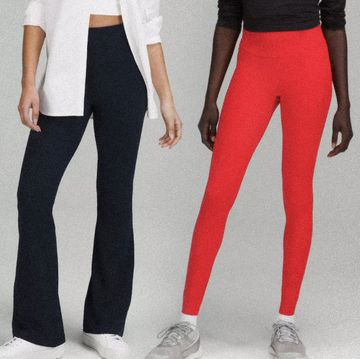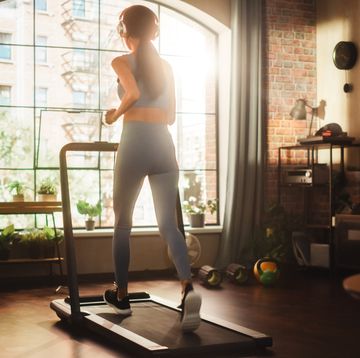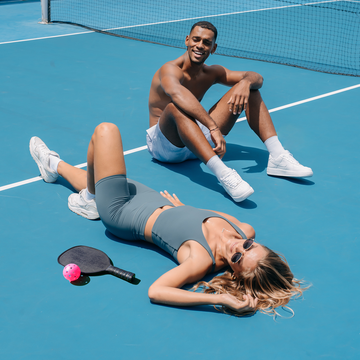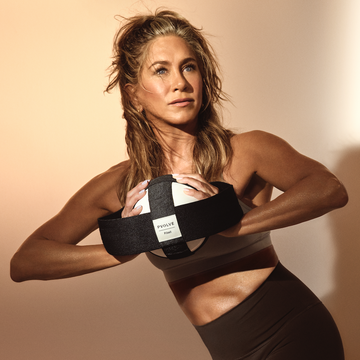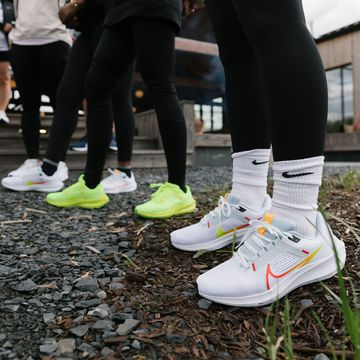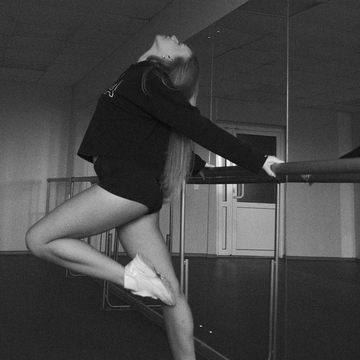As the fitness and health editor at Cosmopolitan.com, I work out every morning before I head into the office. Sometimes I try out new fitness classes, but usually, I'm on my own at the gym, where I do a combo of elliptical or treadmill running, some free weights, and some floor exercises. I have a few go-to moves, but I also work on new exercises I learn on the job. My actual workouts (and my intensity) differ from day to day, depending on what feels sore, what feels jiggly, how much sleep I got, and the amount of time I have before I have to head into work. I generally like the flexibility, but when my arms feel extra firm, or my jeans feel a little tight, I never know exactly what hit me — whether to credit a particular exercise, or blame it. This makes it tough to tweak my habits to achieve better results.
So last month, I signed up for SoulCycle's Turn It Up 20 promotion — a challenge to attend 20 indoor cycling classes at my neighborhood studio in 30 days. (Only the strong survive — and get a *~sPeCiAl~* sweatshirt plus two free classes.)
At first I was super hesitant. I've always liked spinning, but it always leaves me feeling pretty sore. I was worried that taking consecutive classes would ultimately stunt my performance, or worse, lead to some sort of overuse injury. But I was excited to keep my workouts consistent because I thought it would help me figure out how cycling (and other habits that influence my workouts) affect my body. Here's what I learned from doing the exact same workout class at the same time (7 a.m.) almost every day for a month:
1. Just because a class is hard doesn't mean it's effective enough for you. Unlike personal training sessions or workouts you do on your own, fitness classes are designed for a wide range of fitness levels. While I sweat like a beast in every SoulCycle class, I'm used to doing a greater variety of upper-body exercises than the ones used in the upper-body portion of the class. So I started to arrive at class a few minutes early to do some extra arm work. (Yes, I got some weird looks from other riders as they came into class. But I felt better every time I did it.)
2. Pedaling strengthens your legs and butt — but only certain parts of them. I thought I'd emerge from my month of cycling with rock-hard legs and a tight, round butt — full stop. While I noticed some extra definition in my calves and the front of my thighs (which now feel much stronger), cycling didn't necessarily transform my thighs or butt — probably because it only involves one plane of movement (pedaling forward) as opposed to my go-to exercises, which involve 360-degrees of movement:
It's also possible that I was spinning wrong. But I suspect that I'd still neglect certain muscles if I'd done another forward-moving workout (like treadmill running) every day for a month.
3. There's a really big difference between 1-, 2-, 3-, and 5-pound weights. Most indoor cycling classes that involve the upper body use super-light weights. When I used 1- or 2-pound weights, the exercises felt like a breeze. When I upgraded to 3s, I was hurting (in a good way) toward the end of my reps. So it really pays to push yourself if you can still keep proper form — even when your instructor opts for a lighter weight than you do. (Which happened.)
4. Even expensive boutique fitness classes can get a little boring. Treating yourself to a month's worth of $30+ fitness classes might seem like a dream — and in many ways (i.e., ambiance that's more uplifting than the gym) it was. Still, as soon as I got used to the class structure (which is similar in every session), I began to mentally count down to the arms portion of every class, which comes before the second-to-last song.
5. A likeable instructor (with stellar taste in music) can transform your workout — and totally make your day. I didn't jibe with every instructor I met during my challenge — I actually hated one guy, who made annoying and distracting sounds ("Huh! Huh! Huh!") throughout the entire class. But I seriously took to another instructor — and began to look forward to her classes, which were full of awesome energy and enhanced by her penchant for obscure remixes, like Don McLean's "American Pie" mashed up with Florence + The Machine's "Dog Days Are Over." (Love you, Lily! :* )
6. It pays to plan workouts in advance. Because SoulCycle classes fill up quickly, I had to sign up for a whole week's worth of workouts at the beginning of each week. With somewhere to be every day at 7 a.m., on the dot (no refunds for classes you miss!), I knew I couldn't sleep in — and I didn't. Now that I'm back to working out on my own, I snooze my phone alarm like it's my job.
7. You lose when you're late for class. It stresses you out, and detracts minutes and mental energy from your workout. Even if you're not taking a class, you've probably still only budgeted a certain amount of time for your workout. Take it from someone who's perpetually late: It's not that hard to arrive a few minutes early — and it really sets the tone for your workout.
8. You don't always get exactly 45 minutes of exercise in a 45-minute class. Throughout the challenge, I wore a Misfit Shine fitness tracker, which uses a 3-axis accelerometer to track activity. While there could be a margin of error, it tracked only 37 minutes of strenuous activity during my class last week (and less than 45 minutes during every other class I took):
Compare that to my typical hour-long gym sessions, like the one I did this morning:
9. Your pre-workout habits can be just as important as your actual workout. Knowing how much I sweat while I cycle, I started to drink a whole bottle of water before each class. (Many people who work out in the morning recommend this.) I felt much more focused during class, as opposed to lightheaded, which sometimes happens when I work out hard without drinking enough. Now I drink water before I leave my place — and bring a bottle to the gym, which I hadn't been doing before the challenge.
10. Fitness instructors are human too. On some days, I noticed, some instructors stay in the saddle throughout the entire class. On other days, the same instructor might only pedal a little, and spend more time walking around the room. When the latter prevails, I don't know whether she's tired or hungover or just doesn't feel like working out. Whatever it is, it happens — and you can't let your instructor affect the intensity of your workout.
11. Rest days are vital. Spinning five or six days in a row made my legs super sore. Fitness confession: By the end of each week, I had to skimp on bike resistance (a little!) to keep up with the rest of the class. Sometimes I skimped midweek, too, out of fear that I'd be sore the next day.
12. Sleep deprivation throws your body out of wack. Sleep is supposed to give your muscles time to rest and heal, so you don't feel sore as shit the day after a tough workout. I felt especially sore on mornings when I didn't sleep enough, but got up for my 7 a.m. class anyway.
13. Your period really does affect your performance. Not to play the blame game, but a few days before my period, and during the first few days of my cycle, it felt impossible to get out of bed, let alone keep up with the instructor once I got my butt on a bike. It didn't matter what time I what time I went to bed, or that I ate my regular preworkout snack. Later in my cycle, I slept just as much and ate the same breakfast, and I was totally in sync.
14. Awesome indoor cycling skills are non-transferable. I'm a much better indoor cycler than I was 20 classes ago, without a doubt. But some parts (i.e., my ankles, which don't get much lateral play while my feet are strapped into the pedals), are weaker than ever. In a flexibility class I recently took, I could hardly balance on my tippy toes. When I tried standing on a BOSU ball yesterday morning, I lost my balance half way into my reps. And now that I'm back to my regular fitness routine, my legs and butt are mysteriously killing me. It's why cross training (i.e., doing multiple activities) really is a godsend — that way, you never have to sacrifice the strength and stamina you've built up.
15. Haters gonna hate. I felt really proud every time I told someone about my challenge. But lots of people I told (namely, fitness instructors who swear by alternative workout techniques, and friends who prefer other spinning studios) had lots of opinions and concerns about me doing the same workout every day. I get it. But it still felt good to set an exercise agenda and stick it out. And I emerged unscathed — no injuries or anything. Because I generally feel better when I work out on my own (and enjoy the flexibility of throwing in a supervised fitness class here and there), I don't know if I'd do it all again. But I'm definitely glad I did.
Follow Elizabeth on Twitter.

Elizabeth Narins is a Brooklyn, NY-based writer and a former senior editor at Cosmopolitan.com, where she wrote about fitness, health, and more. Follow her at @ejnarins.



